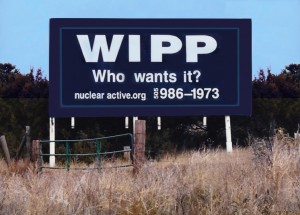WIPP Problems Highlighted in Two DOE Independent Assessments
CCNS NEWS UPDATE
Runs 1/9/15 through 1/16/15
(THEME UP AND UNDER) This is the CCNS News Update, an overview of the latest nuclear safety issues, brought to you every week by Concerned Citizens for Nuclear Safety. Here is this week’s top headline:
* WIPP Problems Highlighted in Two DOE Independent Assessments 
Running a nuclear facility requires periodic equipment maintenance, reviews of safety systems, and extra precautions in order to protect workers, the public and the environment from releases of dangerous radioactive and chemical materials. It is imperative that owners and operators of nuclear facilities make these a priority. Unfortunately, this is not the case for the Nuclear Waste Partnership, a limited liability corporation and contractor for the Waste Isolation Pilot Plant (WIPP), an underground nuclear waste dump located 2,150 feet below the surface in a salt formation 26 miles east of Carlsbad, New Mexico.
In two internal reviews, the U.S. Department of Energy (DOE), the owner of WIPP, found additional problems with the contractor’s work at the site when in February 2014 there was a vehicle fire in the underground and nine days later, a release of plutonium and americium, which contaminated portions of the underground and the surface, when one or more waste drums exploded.
WIPP has not received any shipments since then. It is anticipated to take years and more than $1 billion before any waste is transported for disposal. In September, DOE released a Recovery Plan to resume operations. Unfortunately, the plan is not complete, and the first opportunity for public comment will be on January 14th. http://www.wipp.energy.gov/Special/WIPP%20Recovery%20Plan.pdf
The DOE Office of Enterprise Assessments conducted the two reviews. One review focused on operating diesel equipment, such as salt haulers and machines for installing long bolts into the ceiling, in the underground. Since February the mine has been operating with about one-seventh of the standard airflow, which may be below what is necessary to keep workers safe. The review states, “The most significant concern is that [the contractor] does not have a sound engineering approach for determining the minimum ventilation rates that will ensure safe conditions for underground workers.”
Also, the WIPP Ventilation Plan does not meet U.S. Mine Safety and Health Administration requirements. In particular, the contractor had been using non-approved diesel engines that were banned in 2001. The review states, “[t]he identified deficiencies are significant and need to be addressed before WIPP begins to use diesel engines underground.” http://www.energy.gov/sites/prod/files/2014/12/f19/2014_WIPP_Recovery_Plan_for_Diesel_Equipment_-_December_2014.pdf
The other review points out how the contractor did not conduct basic equipment maintenance as required by DOE orders and the management contract. http://www.energy.gov/sites/prod/files/2014/12/f19/2014_-_WIPP_Conduct_of_Maintenance_Recovery_Plan_-_December_2014.pdf
Because of the problems in 2014, DOE may not pay $8 million in performance bonuses. But the contractor was paid more than $140 million, which is $7 million more than the amount specified when the contract was awarded in 2012. Further, some of the performance measures for 2015 do not match those in the WIPP Recovery Plan, so that the contractor would receive performance bonuses even when it does not meet the milestone schedules.
This has been the CCNS News Update. To learn more, please visit our website at http://www.nuclearactive.org
Tags: americium, DOE, DOE Office of Enterprise Assessments, Nuclear Waste Partnership, plutonium, U.S. Mine Safety and Health Administration, WIPP, WIPP Recovery Plan, WIPP Ventilation Plan















Comments
No comments so far.